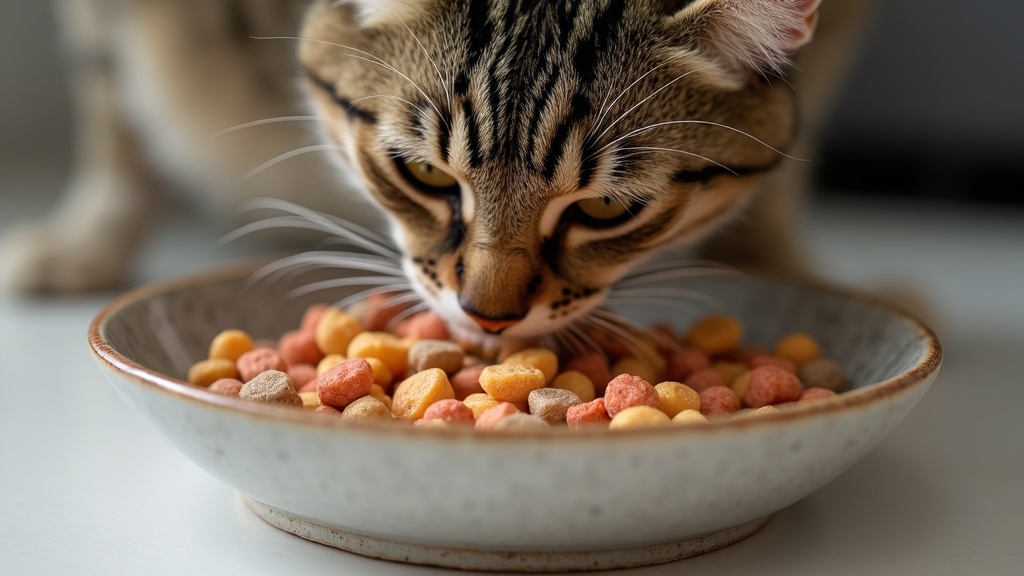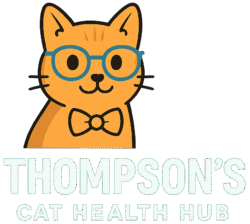Hey there, fellow felines and humans, they call me Thompson, and I know a thing or two about food bowls. Dry cat food, also known as kibble, gets mixed reviews from some cats, but I’m a big fan and know plenty about the upsides from a cat’s-eye view. I’ve crunched my way through all sorts of kibble, and along the way, I’ve learned why a steady supply of those little crunchies can be pretty handy for both cats and the people who feed us. Ready for a closer look at dry cat food benefits from yours truly?

Why Dry Cat Food Is a Popular Pick in Cat Bowls
Dry cat food is everywhere, and it’s not just because it stacks up nicely in the pantry. The kibble life comes with easy storage, long shelf life, and way less mess compared to the squishy stuff. For busy humans, measuring out a scoop or two makes feeding super simple. Plus, you can leave it out all day without stinking up the place or getting that weird crust you find on wet food. Trust me, I’ve seen enough of both.
From my own experience, I love being able to snack on my own schedule. No waiting around for someone to pop a can or splash gravy into my dish. And for multicat households, dry food helps keep the peace. Everyone gets a chance at the bowl, no fighting required, and new cats can be introduced to the routine with less drama. For humans, the freedom to leave food out makes it easier to manage erratic schedules and travel without worrying as much about meal freshness.
Big Advantages of Dry Cat Food for Cats and Humans
Munching on kibble isn’t just about convenience. Here are a few benefits I’ve noticed, both for us cats and our caretakers:
- Stays fresh longer: Unlike wet food, which goes funky pretty fast, dry food keeps its crunch for days in an airtight container.
- Easy to serve: Humans don’t need a fork, spoon, or can opener, just a scoop or a cup does the trick.
- Less stinky: Even for cats like me who love strong scents, it’s pretty nice not having a house that smells like fish stew all day.
- Budgetfriendly: Dry food usually stretches farther for the price, making it easier to feed one, two, or a clowder of cats without breaking the bank.
- Helps with dental health: Crunching on kibble can be useful for knocking some plaque off our teeth, especially for cats who turn their noses up at toothbrushes.
- Convenient for travel: Bringing a bag of dry food is much easier than dealing with cans and the mess that comes with wet food. It packs well and there’s no need for refrigeration.
What Makes Dry Cat Food Special for Us Cats
I’m personally big on routines, and dry cat food fits right in. Here are some things I’ve picked up after years of kibble feasting:
- Free feeding works well: With dry food, you can nibble anytime you please. If there’s always a bit in the bowl, I can snack at sunrise, midday, or even after zoomies at 3 a.m.
- Great for puzzles and treat toys: My human hides dry food in feeder balls and puzzle toys, turning snack time into playtime and making meals more interesting.
- Special recipes for every need: Whether a cat is a kitten, a senior, or needs something grain free, there’s a dry food out there for every taste and health requirement. Some of my friends get indoor formulas to help with hairballs, while others enjoy recipes designed for active outdoor adventurers.
Many dry foods now come in unique shapes and sizes, making it easier for cats with dental issues or sensitive gums to find a kibble that feels just right. My own preference is for the smaller, round pieces that don’t stick to my teeth—and I appreciate how there are choices for those with allergies and sensitivities, too!
Tips for Picking Good Dry Cat Food
Your human might stand in the pet store aisle and wonder which bag to grab. Here’s what matters most, from this cat’s point of view:
- Look for real meat: A good dry food lists chicken, salmon, or another animal protein at the top of the ingredient list.
- Skip the fillers when possible: Some lower quality kibbles are packed with corn, wheat, or soy. Not ideal for most cats, since we do better on proteinrich diets.
- Check for necessary nutrients: Taurine, fatty acids, and vitamins are super important for heart and eye health. Reputable brands balance these out.
- Think about size and shape: Kibble comes in different sizes, which can be easier or harder for certain cats to chew. I’ve tried round, square, and triangle shapes. My teeth like the round ones.
- Doublecheck for recalls: If you’re not sure about a brand, check recent recall history. A food that hasn’t had issues builds trust over time.
Potential Downsides and How to Handle Them
Even though kibble has a lot to offer, there are some things any wise cat (and human) should keep in mind:
- Watch the water intake: Dry cat food doesn’t come with moisture, so I always rely on a fresh water bowl or a fountain nearby. Cats like me aren’t always great at drinking on our own, so this is really important, especially for kidney and urinary health. Some cats might benefit from a water fountain since running water can be more tempting to drink.
- Portion control matters: Munching on kibble can add up, calorie wise. It’s easy to overdo it if the bowl keeps getting refilled. My human uses a scoop to keep my servings in check, which helps keep me at my ideal weight.
- Palatability varies: Not every kibble tastes the same, and some cats (including me!) will give a dramatic flick of the tail if the flavor isn’t up to snuff. Trying a few small bags to see what your cat likes best is a good move.
- Potential allergies: Like with any food, some cats might get itchy skin, digestive issues, or hair loss from certain ingredients. If you spot symptoms, look for an ingredient change or call your vet for advice.
Keeping Meals Interesting
Rotating dry food flavors, adding a few treats, or tossing in some wet food now and then keeps things fun. I look forward to a little variety, and it helps make sure I’m not missing out on any nutrients from a diet heavy on the same ingredient. Pro tip: new flavors also keep picky eaters engaged!
Factors to Consider Before Making Dry Food the Main Event
Switching over to mostly dry cat food comes with a few things to think about:
- Age and health: Kittens need small, nutrientdense kibble, while seniors might appreciate crunchies that are easier on their teeth. Cats with dental issues or special needs could benefit from advice from a vet about softening the food or mixing in wet options to make eating easier.
- Feeding style: Some cats do best with scheduled meals, while others prefer grazing. If your household includes more than one cat (or a dog who likes to sneak snacks), you might need to separate feeding locations or buy kibbledispensing toys to make sure everyone gets their share.
- Sensitivity to ingredients: If I ever get itchy skin or an upset tummy, my human checks the food label to look for potential allergens or irritants, and sometimes tries singleprotein options during elimination diets.
Think about your living environment, too. For instance, small apartments might benefit from less pungent food like dry kibble, while larger families may want several bowls to prevent resource-guarding squabbles.
Dental Health Details
One thing I get asked about a lot (yes, I talk to other cats and even some humans) is how dry food helps with our teeth. While kibble can help with some scraping during chewing, it’s no substitute for regular vet checkups or, if your cat is brave, actual tooth brushing. Still, the crunchy texture sure helps keep tartar down between visits, and my vet says cats with regular dry food access sometimes have fewer dental emergencies than strictly wet food kitties. Chewing also provides a bit of mental stimulation and might curb boredom chewing on other things.
Handy Tips to Get the Most Out of Dry Cat Food
I like to share hacks that make every meal better. Here are things that have worked for me and the cats I know:
- Store it smart: Dry food stays fresher when kept in a sealed container out of direct sunlight. The crunch is the best part, so keep those kibbles crisp. If you have a big bag, don’t pour it all in at once—refill as needed to prevent staleness.
- Mix it up: If you notice me getting bored or picky, mixing in two flavors together keeps things exciting. Seasonal flavors sometimes appear for holidays—worth sampling!
- Add a topper: Sometimes my human adds a sprinkle of freezedried chicken or a splash of tuna juice over the kibble for a tasty upgrade. It makes each bite more appealing and gives a nutrition boost, too.
- Reward with food puzzles: Spreading a handful in a feeder toy is fun and gives me a little workout at mealtime. Food puzzles can help prevent boredom, especially if your human isn’t home all day.
For cats with dietary issues, there are even prescription diets in dry food form that support everything from kidney health to weight management. Ask your vet for the best choice if you have unique needs.
Questions Answered: Dry Cat Food FAQ from a Cat’s Perspective
Question: Can I really eat only dry food?
Answer: Plenty of cats live healthy lives with just dry food, as long as water is always available and the food is complete and balanced. Some cats do better with a mix, and this depends on health needs and personal taste. It’s not unusual for some cats to crave wet food every now and then, especially if they need extra moisture in their diet.
Question: How much dry food should I eat?
Answer: The amount depends on my size, age, and energy level. Check the package for guidelines, but remember these are just a starting point. My human talks to the vet if I ever start looking too fluffy or too skinny! Regular weight checks and adjusting food portions based on activity are good habits for keeping cats healthy.
Question: What if I stop liking my usual kibble?
Answer: Cats are known to suddenly change their minds about food (it’s not just me). Slowly mixing in a new flavor or brand helps avoid tummy upset and gives me time to get used to the change. Gradual introductions keep us from getting grumpy and help avoid digestive hiccups.
Wrapping Up from Thompson
Dry cat food makes mealtime easy, keeps things tidy, and even helps save money, all while giving me a steady source of crunch. It’s not perfect for every cat, but when picked thoughtfully and paired with plenty of water and a bit of variety, it definitely earns its place in my food bowl. If you’ve got questions or want to make the switch, reaching out to your vet is a great first step. Happy crunching!
